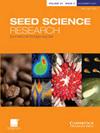The rudimentary embryo: an early angiosperm invention that contributed to their dominance over gymnosperms
IF 1.9
3区 生物学
Q2 PLANT SCIENCES
引用次数: 0
Abstract
In this review, we explore the origin of the rudimentary embryo, its relationship to other kinds of plant embryos and its role in the diversification of angiosperms. Rudimentary embryos have a length:width ratio of ≤2.0, and they have organs, including cotyledon(s) and a primary root. A literature survey failed to reveal rudimentary embryos in the pre-angiosperms, suggesting that this kind of embryo is an angiosperm invention. Although proembryos of some gymnosperms and angiosperms have a length:width ratio of ≤2.0, they have not formed meristems or organs. Thus, rudimentary embryos are not proembryos. During the development of rudimentary embryos in monocots and dicots (all non-monocots), the growth pattern of the epicotyledonary cells differs, resulting in differences in the placement of the shoot meristem and in one versus two cotyledons, respectively, but the embryo size is similar. Rudimentary embryos grow inside the seed prior to germination, which is true for linear-underdeveloped embryos, including those in some gymnosperms. Rudimentary embryos served as the starting point for the great diversification of embryos, and ultimately of seeds, in angiosperms, and they are still present in many families of extant angiosperms. The rudimentary embryo is part of the syndrome of changes, including increased speed of pollen germination and pollen tube growth, simplification of the female gametophyte, development of endosperm and elimination of multiple embryo production from each zygote, that distinguish angiosperm seed production from that of gymnosperms. We conclude that the rudimentary embryo was one of many new developments of angiosperms that contributed to their great success on earth.原始胚胎:早期被子植物的一种发明,使它们优于裸子植物
在这篇综述中,我们探讨了初级胚胎的起源,它与其他类型植物胚胎的关系,以及它在被子植物多样化中的作用。初级胚胎的长宽比≤2.0,它们有器官,包括子叶和主根。一项文献调查未能揭示前被子植物中的初级胚胎,表明这种胚胎是被子植物的发明。尽管一些裸子植物和被子植物的原胚长宽比≤2.0,但它们没有形成分生组织或器官。因此,未发育的胚胎不是原胚胎。在单子叶植物和双子叶植物(所有非单子叶植物)的初级胚胎发育过程中,上胚轴细胞的生长模式不同,导致芽分生组织和一个与两个子叶的位置不同,但胚胎大小相似。萌芽前,种子内部生长着初级胚胎,包括一些裸子植物中的线性发育不全胚胎也是如此。在被子植物中,初级胚胎是胚胎和种子巨大多样化的起点,它们仍然存在于许多现存被子植物科中。初级胚胎是变化综合征的一部分,包括花粉萌发和花粉管生长速度的加快、雌配子体的简化、胚乳的发育以及每个受精卵的多胚产生的消除,这些都是被子植物种子产生与裸子植物种子产生的区别。我们得出的结论是,原始胚胎是被子植物在地球上取得巨大成功的众多新发展之一。
本文章由计算机程序翻译,如有差异,请以英文原文为准。
求助全文
约1分钟内获得全文
求助全文
来源期刊

Seed Science Research
生物-植物科学
CiteScore
3.60
自引率
4.80%
发文量
23
审稿时长
>12 weeks
期刊介绍:
Seed Science Research, the official journal of the International Society for Seed Science, is a leading international journal featuring high-quality original papers and review articles on the fundamental aspects of seed science, reviewed by internationally distinguished editors. The emphasis is on the physiology, biochemistry, molecular biology and ecology of seeds.
 求助内容:
求助内容: 应助结果提醒方式:
应助结果提醒方式:


